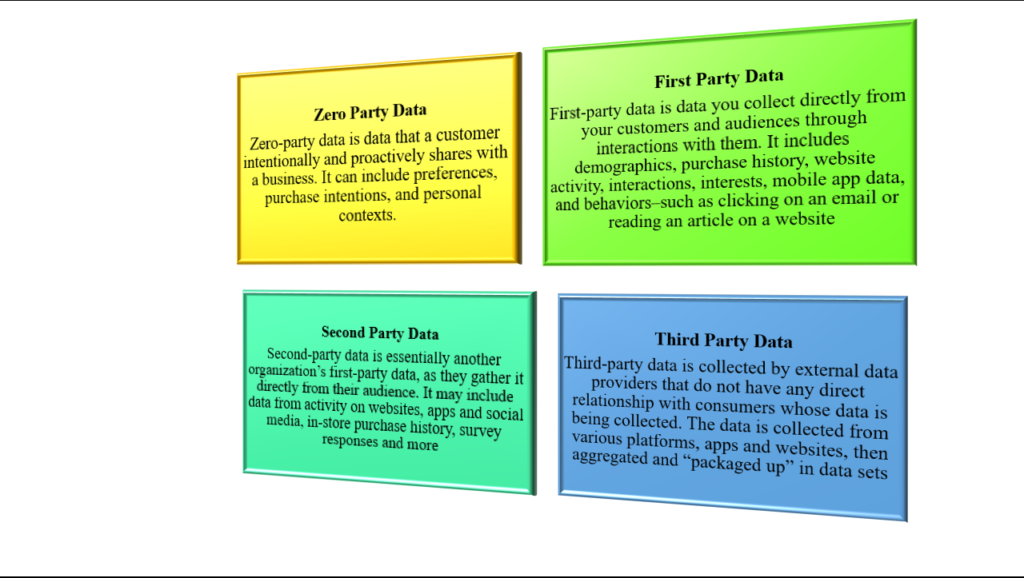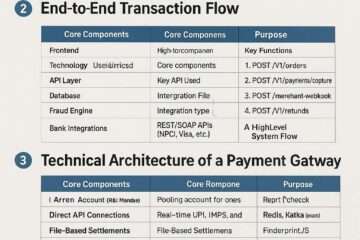

First-party data is the valuable information that companies gather directly from their customers and audiences through their own channels. This data is usually collected through customer interactions, website visits, transactions, and other direct engagements. It is considered the most valuable data type for businesses due to its direct source, ensuring accuracy and reliability.
It is a valuable asset that offers valuable insights to create more focused and customized campaigns, strengthen customer relationships, and enhance overall marketing effectiveness. In addition, responsibly utilizing first-party data is crucial for establishing customer trust and ensuring compliance with privacy regulations.
This article provides valuable insights on efficiently gathering and utilizing first-party data to enhance marketing strategies while adhering to privacy regulations. We’ll also discuss zero-party data, which is gaining traction in the data collection industry.
Exploring different types of customer data and maximizing their potential
There are multiple ways to gather customer data, each with its own unique qualities and considerations. Choosing the right data collection method relies on various factors, including research goals, the type of data required, and practical considerations like budget and availability. By utilizing various approaches, a more holistic view of customer behavior and preferences can be obtained.

Now, let’s explore various data types.
Data collected directly from our customers-First Party Data
First-party data refers to the valuable information collected directly from a company’s customers or users. It is achieved through a range of interactions between the company and its audience.
Companies collect various types of first-party data:
- Tracking and analyzing website or app interactions, including web analytics, user registrations, and online behavior.
- Transactional data includes purchase history and order details.
- Gathering customer feedback from surveys, reviews, and feedback forms.
- Customer interactions are stored and managed in customer relationship management (CRM) platforms.
- Customers willingly share their data directly with the company, establishing a strong foundation of trust. In return, companies gain valuable insights from this data.
In addition, first-party data is typically more accurate compared to other types of data that may originate from sources with less reliable evaluation methods.
Collecting and utilizing first-party data necessitates companies to comply with privacy regulations and acquire appropriate user consent. Companies are required to comply with data privacy laws like the General Data Protection Regulation (GDPR) or the California Consumer Privacy Act (CCPA) which govern the usage and management of personal information.
In a report by Deloitte, 73% of respondents believe that using first-party data would mitigate the impact of the rise of privacy awareness.
Methods for gathering first-party data
Implementing an analytics platform on your website can greatly enhance your ability to track user behavior and extract valuable insights. Metrics such as page views, bounce rates, time on site, and user demographics can be analyzed. Through the use of event tracking, you have the ability to analyze and evaluate particular interactions such as button clicks, downloads, and form submissions.
Encouraging users to register or create accounts on your website enables the collection of valuable information such as names, email addresses, and preferences during the registration process. Utilize the data from registered users to create personalized experiences and execute targeted marketing campaigns.
By incorporating newsletter sign-up forms on your website, you have the opportunity to capture valuable user information, particularly email addresses. Utilizing newsletter subscriptions allows you to create a database of active users and streamline personalized communication. Another way to gather user data is by utilizing contact forms. By incorporating fields that request important details like names, email addresses, and other valuable information, you can significantly boost your marketing efforts.
Crafting surveys or feedback forms is a straightforward approach to gathering valuable insights from visitors to your website. Feel free to inquire about user preferences, satisfaction levels, and other pertinent subjects. Offering incentives can be a great way to motivate users to share their feedback.
When it comes to websites with an ecommerce component, it’s crucial to prioritize the utilization of data. This involves gathering information on purchased products, order frequency, and average order value. This information enables the generation of personalized product recommendations, empowering users to make well-informed shopping choices.
Integrating social media platforms with your website helps gather valuable data on social interactions. It’s important to keep an eye on the social engagement your content receives and use social media analytics tools to gain more valuable insights.
By utilizing tools that track user behavior, such as heatmaps and session recordings, one can gain valuable insights into user navigation patterns, dwell times, and interactive elements. Utilize this data to enhance the user experience and customize your content accordingly.
Implementing a cookie consent mechanism is necessary to comply with privacy regulations when collecting information about user preferences and behavior through cookies. Utilizing the data collected throughout the process enables the customization of content and advertisements.
By defining custom events and goals in your analytics platform, you can effectively track and analyze specific user interactions. Actions such as video views, form submissions, and button clicks help you gain deeper insights into user engagement and optimize your website to extract the most out of your paid traffic. Additionally, it is crucial to optimize the user interface to ensure that visitors have a seamless experience on the website, ultimately leading to higher conversion rates.
Tools for collecting first-party data
There are a variety of tools available to assist businesses in gathering first-party data from various channels and touchpoints. The selection of tools is determined by the unique requirements of the company and the manner in which it engages with customers.
These are some commonly used tools for gathering first-party data:
- Some popular analytics platforms include Google Analytics.
- For CRM software, Hubspot and Salesforce are widely used.
- Tag managers available include Piwik PRO Tag Manager and Matomo Tag Manager.
- Customer data platforms: Tealium Online surveys: Mailchimp and SurveyMonkey
- Popular customer feedback platforms include Trustpilot and Reviews.io.
Second Party Data
Second-party data refers to information that is obtained directly from another organization or entity, rather than from the original source or the individual themselves.
Second-party data is the term used to describe the first-party data of one company that is directly exchanged or sold to another company. Both parties in this data-sharing agreement willingly trade data with each other. Data sharing of this nature frequently takes place through established alliances, cooperative efforts, or explicit contracts between corporations.
The exchange of second-party data is contingent upon a strong level of trust between the two parties involved. Both organizations must ensure that the shared data is precise, pertinent, and acquired with appropriate authorization from the individuals concerned.
Second-party data is derived from the first-party data of another organization, making it often regarded as having superior quality and accuracy compared to third-party data obtained from external sources.
Methods for acquiring second-party data
Second-party data is acquired through direct cooperation or alliances. These are the typical origins of second-party data:
- Data exchange platforms (DEPs) include Snowflake Data Marketplace and AWS Data Exchange.
- Customer data platforms (CDPs) include Segment and Tealium AudienceStream.
- Application programming interfaces (APIs) include REST APIs and GraphQL. Data management platforms (DMPs) include Adobe Audience Manager and Lotame.
- Data governance platforms (DGPs) include Collibra and Alation.
Third Party Data
Third-party data is data that is gathered, combined, and sold by entities that are different from the ones that originally collected the data and the final user. In the realm of digital marketing and data analytics, third-party data is frequently acquired from external sources and encompasses a diverse array of demographic, behavioral, and interest-related information pertaining to individuals. Data brokers, aggregators, or other specialized third-party entities frequently acquire and sell this data.
Data obtained from external sources may vary in terms of its quality and accuracy. Due to its origin from other sources, the freshness, relevancy, and completeness of the information may be uncertain.
The utilization of third-party data gives rise to multiple privacy concerns. Organizations are required to comply with data protection requirements while obtaining, keeping, and utilizing such data, which is significantly more difficult to accomplish compared to first-party data. Individuals may lack awareness of third-party data collection and the exact information to which these parties have access.
Furthermore, there are apprehensions regarding the utilization of third-party data in programmatic advertising. The General Data Protection Regulation (GDPR) requires obtaining user agreement for the acquisition of data, which has a direct effect on the development of third-party cookies. Mozilla Firefox and Apple Safari have incorporated functionalities such as intelligent tracking prevention (ITP) and enhanced tracking protection (ETP) to automatically obstruct third-party cookies. Originally, Google Chrome had intended to gradually eliminate third-party cookies by 2022.
However, they have now decided to extend this schedule to the latter half of 2024. This adjustment is aimed at striking a compromise between safeguarding user privacy and ensuring the continued existence of an advertising-supported internet. By default, Safari and Firefox automatically prevent third-party cookies, providing users with more privacy.
Methods for acquiring third-party data
Third-party data encompasses diverse categories and originates from a multitude of sources, including:
- Data brokers specialize in the collection, aggregation, and sale of diverse forms of data.
- Platforms that aggregate and disseminate data produced through user interactions on their websites.
- Market research firms that perform research studies and surveys to collect data on consumer habits, preferences, and trends.
- Social media sites that collect user-generated data, such as profiles, interests, and social interactions.
- Location-based services acquire location data from users’ devices, including GPS applications, mapping services, and location-based applications.
- Surveys and panel providers are entities that carry out surveys or manage groups of individuals for the aim of collecting data.
- Ecommerce platforms that gather and retain data regarding client transactions, preferences, and behaviors.
Zero Party Data
Zero-party data is the valuable information that individuals willingly and actively provide to a company or organization. Unlike first-party data, which is gathered through implicit actions, zero-party data is willingly provided by the customers themselves. Users willingly share this type of data, often in the form of preferences, intentions, or personal information. Zero-party data is extremely valuable for businesses.
Building a collection of zero-party data relies on trust and transparency. It is crucial for companies to provide clear communication regarding data usage and empower individuals to have control over their personal information.
Methods for gathering zero-party data
Companies have the opportunity to acquire zero-party data through:
- Gathering insights from customers regarding their preferences for product features, content types, or communication frequency.
- Collecting data from surveys or questionnaires aimed at gaining insights into customer opinions, needs, or feedback.
- Gathering user-generated content, such as reviews, ratings, and comments, to gain valuable insights into their experiences.
- Emphasizing the importance of opt-in choices for newsletters, promotions, or other marketing communications.
- Gathering data to customize the user experience, including website and content preferences, as well as notification settings.
Which type of customer data would be more advantageous?
First-party and zero-party data are highly regarded for their value compared to other types of data. This is due to their direct interactions and explicit consent, which aligns perfectly with privacy regulations.
Second-party data, much like first-party data, entails the sharing and collaboration of data between trusted partners. However, the partner must still obtain customer consent, so the process of collecting customer data is typically quite secure.
However, third-party data is not as reliable and can potentially raise privacy concerns since it is often collected without the individuals’ knowledge or consent.
To ensure your company places a high value on customer privacy and trust, it is important to emphasize the collection of first-party data, complemented by zero-party data. It provides a valuable source of information and offers a privacy-compliant approach to gaining a deeper understanding of your customers.
Utilizing first-party data to enhance your marketing strategy
Utilizing first-party data is essential for enhancing marketing strategy. Here are several methods you can utilize.
Customized advertising
Utilizing first-party data allows for the creation of incredibly tailored marketing campaigns.
To accomplish this effectively, you can, for instance:
Efficiently manage and analyze customer data by centralizing it in a CRM system for easy access.
Segmenting audiences based on shared characteristics allows for the creation of detailed buyer personas that accurately represent ideal customers.
Furthermore, it can be utilized to create personalized email campaigns, offer customized suggestions, or integrate dynamic website content, such as dynamic forms, adaptive menus, real-time social media feeds, or user-specific notifications.
Provide special offers or promotions that are tailored to customer preferences in order to enhance personalization even more.
Create targeted content for specific customer segments using social media marketing. Ensure customer data privacy and obtain proper consent for usage. Consistently track and evaluate the outcomes of customized marketing campaigns, such as levels of engagement and conversion rates. By continuously refining strategies, you can ultimately enhance customer satisfaction and loyalty.
Segmentation and targeting
Segmentation and Targeting are crucial aspects of any successful marketing strategy. By understanding the different segments within your target market and tailoring your messaging and offerings to meet their specific needs and preferences, you can effectively reach and engage with your audience. This approach allows you to focus your resources and efforts on the most promising opportunities, maximizing your chances of success. Understanding and categorizing your audience based on directly collected information is crucial for effective segmentation and targeting.
First, it is important to establish specific criteria for segmentation, including factors like age, location, and buying behavior. By carefully examining the data, patterns can be identified and analyzed. As a marketing analyst, you have the ability to create distinct customer segments, each with its own detailed buyer persona that takes into account unique attributes and behaviors.
Utilizing this data allows for the customization of marketing messages, such as personalized email campaigns, tailored website content, and dynamic ad campaigns, to effectively cater to the unique needs and interests of each segment. In addition, it has the potential to create tailored offers and promotions that cater to the specific preferences of different groups.
With the help of first-party data, companies have the ability to constantly refine their segmentation strategies by analyzing changes in customer behavior and market dynamics.
Ensuring customer loyalty and satisfaction
Having access to a comprehensive dataset that encompasses customer purchase history, preferences, and interactions is essential for effective customer retention strategies. By analyzing data, one can uncover patterns and gain a deeper understanding of customer behavior, which in turn can be used to enhance relationships with current customers.
Utilizing first-party data for customer retention involves:
- Creating email campaigns that take into account customers’ previous purchases, providing them with exclusive promotions, and delivering personalized content based on their preferences.
- Understanding customer preferences and offering tailored recommendations based on their past selections.
- Creating loyalty programs and personalized incentives to reward and retain valued customers.
- Consistently evaluating customer feedback and satisfaction data, promptly addressing concerns to improve the overall customer experience.
Promoting additional products and maximizing sales potential
Utilizing first-party data for cross-selling and upselling requires a thoughtful strategy to tailor recommendations according to customer preferences and interactions. Through the consolidation of detailed customer profiles, businesses have the ability to categorize their customer base based on purchasing patterns.
By analyzing first-party data, you can easily identify natural cross-selling opportunities. This allows you to recommend related products or services that perfectly complement previous purchases. Creating customized upselling offers involves analyzing the customer’s purchasing habits and preferences, and offering enhanced choices that enhance the value of their purchases. In addition, the careful combination of products, customized email campaigns, and dynamic website content can greatly improve the success of cross-selling and upselling initiatives.
Maximizing the effectiveness of ad and email marketing campaigns
By utilizing data collection, one can effectively tailor ad and email campaigns to cater to specific customer segments, ensuring that the messaging resonates with their unique interests.
There are multiple strategies to enhance marketing campaigns, including:
- Highlighting products or services by leveraging customers’ interactions to create engaging content and personalized recommendations in advertisements and email campaigns.
- Utilizing behavioral triggers, such as abandoned carts or previous purchases, to send timely and relevant messages.
- Driving customer engagement and boosting conversions through personalized offers and discounts tailored to individual preferences and purchase history.
- Ensuring a seamless customer experience by maintaining consistency across various channels and conducting A/B testing.
- In addition, landing pages tailored to specific segments and the integration of customer feedback help improve and optimize marketing efforts. Additionally, it is crucial to adhere to privacy regulations and acquire explicit consent, highlighting the significance of transparency and building trust with customers.
Maximizing the efficiency and effectiveness of products and services
Optimization involves strategically refining offerings by leveraging customer data insights. Through the collection of comprehensive first-party data, one can gain valuable insights into customer experiences and expectations. This allows for the identification of recurring patterns and opportunities for enhancement. As a marketing analyst, you have the ability to assess customer usage patterns and behaviors in order to identify features that are well-received and areas that could benefit from improvement.
With that data, you have the ability to:
- Customize offerings based on individual preferences, suggest related products, and predict future needs using predictive analytics.
- Implementing iterative testing and improvement strategies is crucial for optimizing performance. This involves conducting A/B testing, refining user interfaces, and making adjustments to service delivery processes.
- Maximize customer journeys, implement updates and features based on data insights, and improve customer support services by proactively resolving common issues.
- Assess pricing strategies and compare them to competitors to maintain a competitive edge.
- Continuously improve and adjust products and services to meet changing customer demands and market trends.
Enhanced user experience
Utilizing first-party data can greatly enhance the user experience of your website or app. It is highly beneficial for tailoring website content, providing personalized recommendations for products and services, and optimizing the customer experience.
By leveraging first-party data, we can improve the relevance of interactions and make user navigation more seamless. In addition, utilizing first-party data can enhance customer support services by gaining a deep understanding of customer histories and preferences.
With this expertise, customer support teams can enhance their interactions by offering tailored solutions that perfectly match the individual requirements of each user, resulting in more personalized and efficient support. By incorporating first-party data into your strategy, you can establish a digital environment that prioritizes user satisfaction, engagement, and long-term loyalty.
Increase user acquisition
Utilizing first-party data strategically can greatly enhance the precision and impact of user acquisition strategies. By studying the characteristics of their existing customers, businesses can effectively identify and attract similar audiences, enabling them to create targeted campaigns.
This strategy boosts the effectiveness of user acquisition efforts and improves the chances of reaching individuals who have similar characteristics to the existing customer base. By leveraging first-party data, businesses can fine-tune and enhance their user acquisition strategies to achieve greater precision and success in expanding their customer base.
A/B testing
Finally, businesses have the ability to conduct meaningful experiments using insights from A/B testing and optimization strategies. With a data-driven approach, you can make informed decisions and pinpoint the factors that drive higher engagement and conversion rates.
By incorporating first-party data into the A/B testing process, businesses can iteratively tailor their offerings and messaging to better align with the preferences and behaviors of their diverse customer base.
Exploring the future of data collection and privacy
The convergence of first-party data and privacy is a crucial and ever-changing field influenced by technological progress, regulatory shifts, and evolving consumer demands. Privacy regulations are being implemented and strengthened by countries and regions worldwide, with the aim of giving individuals more control over their personal data and ensuring that businesses handle data responsibly.
Consumers are becoming more aware of data privacy concerns due to well-publicized data breaches, scandals, and increased media attention. According to Verizon’s data breach investigation report, the majority of breaches (74%) were attributed to human error, social engineering attacks, or data misuse.
Customers now have a better understanding of how their data is collected, used, and shared. They are particularly drawn to businesses that prioritize transparency in their data practices and offer ways for individuals to have control over their personal information. As per Razorfish, a significant majority of US consumers believe that a company’s openness regarding their intentions with personal data is crucial for building trust. According to the survey, a majority of participants indicated that they would be more inclined to trust a company that avoids unnecessary collection of personal data.
Companies are increasingly realizing the importance of zero-party data that customers willingly and proactively provide. This shift requires gaining explicit consent and establishing trust by enabling users to share information on their own terms.
Another important aspect to consider is the growing development and adoption of privacy-enhancing technologies (PETs). They incorporate various tools and techniques that enable data analysis while ensuring the protection of individual privacy. These include federated learning, secure multi-party computation, and differential privacy. Companies are actively exploring various techniques to de-identify or anonymize data in order to safeguard individual privacy while still extracting valuable insights. This requires removing personally identifiable information (PII) from datasets.
Here are some widely used data anonymization methods:
- Replacing identifying data with a pseudonym or token, a common practice in data protection.
- Removing direct and indirect identifiers.
- Data masking is the process of substituting real data with fictional data within a dataset.
- Data aggregation involves presenting collected data as aggregated values without any attributes attached. This method is the only one that cannot be undone.
- In addition, companies are increasingly investing in advanced consent management systems to acquire and handle user consent for data collection and processing. It involves offering users the ability to choose which data they feel comfortable sharing, with a high level of control.
Overall, ethical considerations in data collection and usage are becoming increasingly important for companies. This entails ensuring that data is utilized responsibly and for the mutual benefit of businesses and consumers. Adapting to changes in regulations, technology, and consumer expectations is crucial in the ever-evolving privacy landscape. Being well-informed and proactive in addressing privacy concerns is absolutely essential.
Elevating the potential of first-party data
Utilizing first-party data allows for a privacy-conscious and consumer-centric approach to develop highly focused marketing strategies that drive overall growth and success. Businesses that place a high value on transparency, user control, and ethical data practices are more likely to thrive in this ever-changing landscape.



























































